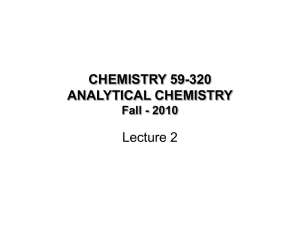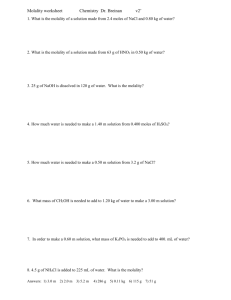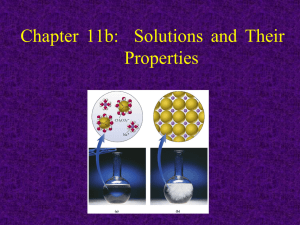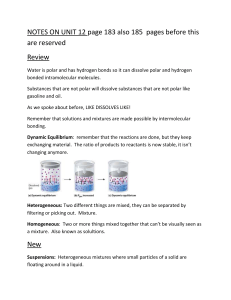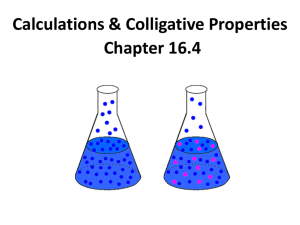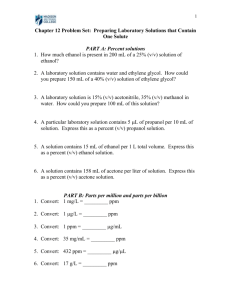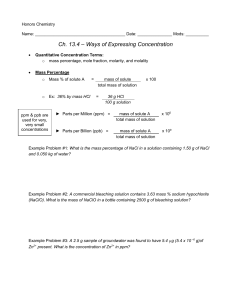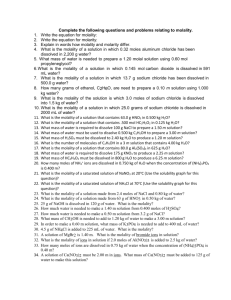File - Chemistry 11 Enriched
advertisement
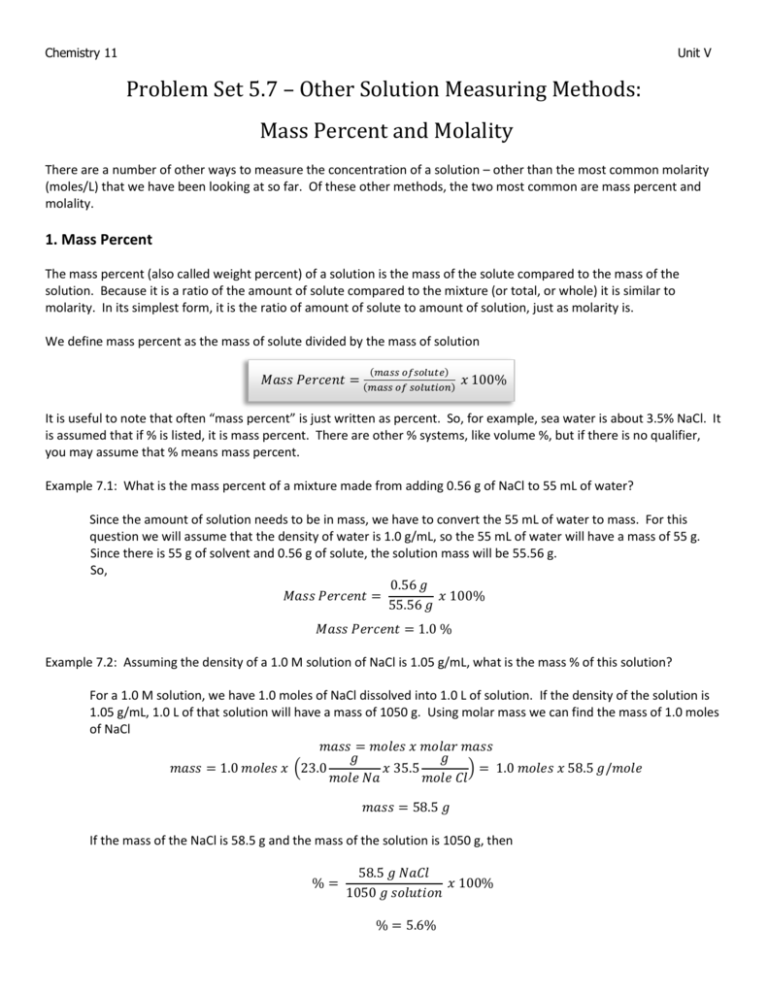
Chemistry 11 Unit V Problem Set 5.7 – Other Solution Measuring Methods: Mass Percent and Molality There are a number of other ways to measure the concentration of a solution – other than the most common molarity (moles/L) that we have been looking at so far. Of these other methods, the two most common are mass percent and molality. 1. Mass Percent The mass percent (also called weight percent) of a solution is the mass of the solute compared to the mass of the solution. Because it is a ratio of the amount of solute compared to the mixture (or total, or whole) it is similar to molarity. In its simplest form, it is the ratio of amount of solute to amount of solution, just as molarity is. We define mass percent as the mass of solute divided by the mass of solution (𝑚𝑎𝑠𝑠 𝑜𝑓𝑠𝑜𝑙𝑢𝑡𝑒) 𝑀𝑎𝑠𝑠 𝑃𝑒𝑟𝑐𝑒𝑛𝑡 = (𝑚𝑎𝑠𝑠 𝑜𝑓 𝑠𝑜𝑙𝑢𝑡𝑖𝑜𝑛) 𝑥 100% It is useful to note that often “mass percent” is just written as percent. So, for example, sea water is about 3.5% NaCl. It is assumed that if % is listed, it is mass percent. There are other % systems, like volume %, but if there is no qualifier, you may assume that % means mass percent. Example 7.1: What is the mass percent of a mixture made from adding 0.56 g of NaCl to 55 mL of water? Since the amount of solution needs to be in mass, we have to convert the 55 mL of water to mass. For this question we will assume that the density of water is 1.0 g/mL, so the 55 mL of water will have a mass of 55 g. Since there is 55 g of solvent and 0.56 g of solute, the solution mass will be 55.56 g. So, 0.56 𝑔 𝑀𝑎𝑠𝑠 𝑃𝑒𝑟𝑐𝑒𝑛𝑡 = 𝑥 100% 55.56 𝑔 𝑀𝑎𝑠𝑠 𝑃𝑒𝑟𝑐𝑒𝑛𝑡 = 1.0 % Example 7.2: Assuming the density of a 1.0 M solution of NaCl is 1.05 g/mL, what is the mass % of this solution? For a 1.0 M solution, we have 1.0 moles of NaCl dissolved into 1.0 L of solution. If the density of the solution is 1.05 g/mL, 1.0 L of that solution will have a mass of 1050 g. Using molar mass we can find the mass of 1.0 moles of NaCl 𝑚𝑎𝑠𝑠 = 𝑚𝑜𝑙𝑒𝑠 𝑥 𝑚𝑜𝑙𝑎𝑟 𝑚𝑎𝑠𝑠 𝑔 𝑔 𝑚𝑎𝑠𝑠 = 1.0 𝑚𝑜𝑙𝑒𝑠 𝑥 (23.0 𝑥 35.5 ) = 1.0 𝑚𝑜𝑙𝑒𝑠 𝑥 58.5 𝑔/𝑚𝑜𝑙𝑒 𝑚𝑜𝑙𝑒 𝑁𝑎 𝑚𝑜𝑙𝑒 𝐶𝑙 𝑚𝑎𝑠𝑠 = 58.5 𝑔 If the mass of the NaCl is 58.5 g and the mass of the solution is 1050 g, then %= 58.5 𝑔 𝑁𝑎𝐶𝑙 𝑥 100% 1050 𝑔 𝑠𝑜𝑙𝑢𝑡𝑖𝑜𝑛 % = 5.6% Chemistry 11 Unit V 2. Molality Unlike molarity and mass percent, the molality of a solution is a ratio of the solute to the solvent. Molality is given the lowercase m as its letter, and is defined as the number of moles of solute per kilogram of solvent. 𝑚𝑜𝑙𝑎𝑙𝑖𝑡𝑦 = 𝑚𝑜𝑙𝑒𝑠 𝑠𝑜𝑙𝑢𝑡𝑒 𝑘𝑖𝑙𝑜𝑔𝑟𝑎𝑚 𝑜𝑓 𝑠𝑜𝑙𝑣𝑒𝑛𝑡 Molality is useful for a number of different reasons because it compares solute to solvent, and not solute to the combination of solvent and solute. We will explore some of these reasons in the next problem set. Example 7.3: 4.0 grams of sugar (C6H12O6) are dissolved into 350 g of tea. What is the molality of the sugar in the solution? Since molality is moles of solute per kg of solvent, we first find these two values. First, the moles of solute. 𝑚𝑜𝑙𝑒𝑠 𝑠𝑜𝑙𝑢𝑡𝑒 = 𝑚𝑜𝑙𝑒𝑠 𝑠𝑢𝑔𝑎𝑟 = 𝑔𝑟𝑎𝑚𝑠 𝑀𝑜𝑙𝑎𝑟 𝑀𝑎𝑠𝑠 4.0𝑔 𝑔 𝑔 𝑔 (6 𝑥 12 ) + (12 𝑥 1 ) + (6 𝑥 16 ) 𝑚𝑜𝑙𝑒 𝑚𝑜𝑙𝑒 𝑚𝑜𝑙𝑒 𝑚𝑜𝑙𝑒𝑠 𝑜𝑓 𝑠𝑢𝑔𝑎𝑟 = 4.0𝑔 𝑔 180 𝑚𝑜𝑙𝑒 𝑚𝑜𝑙𝑒𝑠 𝑜𝑓 𝑠𝑢𝑔𝑎𝑟 = 0.012 𝑚𝑜𝑙𝑒𝑠 Next, we need to find the kg of solvent: 350 𝑔 𝑡𝑒𝑎 = 0.350 𝑘𝑔 𝑡𝑒𝑎 So, the molality is 𝑚= 0.012 𝑚𝑜𝑙𝑒𝑠 𝑠𝑢𝑔𝑎𝑟 0.350 𝑘𝑔 𝑠𝑜𝑙𝑣𝑒𝑛𝑡 𝑚 = 0.063 𝑚𝑜𝑙𝑒𝑠/𝑘𝑔 Example 7.4: If the molarity of a solution is very small, show that the molality of a solution is virtually the same as the molarity. Suppose we have a very dilute, 0.0010 M solution of NaCl. Remembering that the density of water is 1.0 g/mL, this means that 1.0 L (1000 mL) of water has a mass of 1.0 kg (1000 g). In our 0.0010 M solution, there is 0.0010 moles of NaCl. The molar mass of NaCl is 58.5 g/mole, so the mass of 0.0010 moles is 0.0585 g. This very small mass means that our 1.0 L of solution will be very close to 1.0 kg. Because the solution will be very close to 1.0 kg then 0.0010 𝑚𝑜𝑙𝑒𝑠 𝑠𝑜𝑙𝑢𝑡𝑒 𝑚𝑜𝑙𝑎𝑙𝑖𝑡𝑦 = 1.0 𝑘𝑔 𝑠𝑜𝑙𝑣𝑒𝑛𝑡 𝑚𝑜𝑙𝑎𝑙𝑖𝑡𝑦 = 0.0010 𝑚𝑜𝑙𝑒𝑠/𝑘𝑔 So, the molarity of 0.0010 M solution will be very close to 0.0010 m as well. Chemistry 11 Unit V Questions for further understanding: Part 1: Mass Percent Questions 7.1 7.2 7.3 7.4 7.5 7.6 7.7 What is the mass percent of a solution which has 1.0 g of NaCl dissolved in 10.0 g of solvent? What is the mass percent of a solution which has 1.0 g of AlCl3 dissolved in 10.0 g of solvent? A solution is 2.3% LiF. What mass of LiF would be found in 35.0 g of the solution? A solution is 1.56% MgBr2. If a sample contains 10.0 g of MgBr2, what is the mass of the solution? A solution is 5.08% KF. If a sample contains 1.0 g of KF, what is the mass of water used to dissolve? The density of a 0.04% solution of KI is 1.0 g/mL. What is the molarity of the solution? The density of a 0.04% solution of LiF is 1.0 g/mL. What is the molarity of the solution? Part 2: Molality Questions 7.8 7.9 7.10 7.11 What is the molality of a solution made from mixing 1.0 g of NaCl with 10.0 g of water? What is the molality of a solution made from mixing 1.0 g of AlCl3 with 10.0 g of water? A solution has a molality of 1.4 moles/kg. What mass of KBr would be needed to mix with 500 g of water? A lab technician needs a solution of CH3OH (methanol) that has a molality of 1.0 mole/kg. What volume of water would she need if she has a 10.0 g sample of CH3OH? Assume the density of water is 1.0 g/mL Mixed Questions 7.12 7.13 7.14 7.15 What is the molality of a 3.5% NaCl solution? What is the mass % of a 1.45 molal solution of KBr? A FeI2 solution has a concentration of 0.035 M. If the density of this solution is 1.02 g/mL, what is its mass %? If a Pb(NO3)2 solution has a mass % of 2.0 %, what is its molarity (in mole/L) if the density of the solution is 1.0 g/mL? Answers: 7.1: 9.1% 7.5: 18.7 g 7.9: 0.75 m 7.13: 14.7% 7.2: 9.1% 7.6: 0.0024 M 7.10: 80 g 7.14: 1.1% 7.3: 0.81 g 7.7: 0.015 M 7.11: 310 mL 7.15: 0.060 M 7.4: 641 g 7.8: 1.7 m 7.12: 0.62 m

